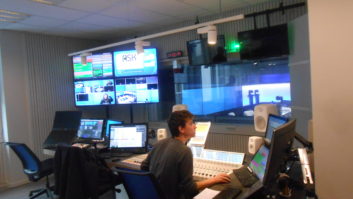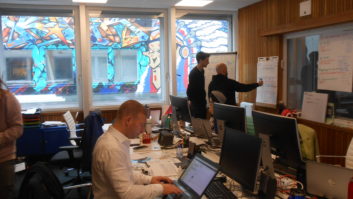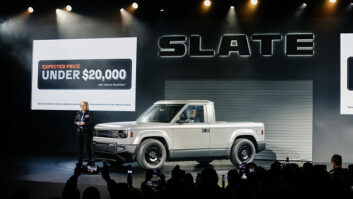BRUSSELS — With the introduction of its new “FlexiProd” project, RTBF radio is preparing for the future, both in terms of content and infrastructure. “Our FlexiProd plan wants to bring ‘making radio’ to the next level — an evolution toward digital hybrid smart radio with a signature sound but richer, more interactive, social and visual.” That’s how Francis Goffin, director general of RTBF radio (www.rtbf.be/radio), sees the future for the Belgian French-language broadcaster.
CONTENT
FlexiProd is about the complete reorganization and change of the working process. The project involves a substantial investment in new studios and equipment — evolution toward visual radio, self-op production and on-air studios for maximum flexibility. The scheme involves the development of eight new on-air studios and 14 “self-prod” production/editing cells.


Laurent Finet, director of radio
production and digital innovation
says that the FlexiProd project is
leading the way to “smart radio.”
Photo courtesy of RTBF “Flexible production is what FlexiProd stands for,” explains Laurent Finet, director of radio production and digital innovation.
“Like most public services, the RTBF is facing financial cutbacks. At the same time we, as a state broadcaster, are dealing with major challenges as regards the evolution of radio, such as visual radio, social media, streaming and podcasts. We must reorganize ourselves in order to allow our staff to think and work differently, and also adapt the tools accordingly.”
Finet wants to tear down the walls between the different tasks — the era where a presenter stuck to his presentation job, the production assistant administered the agenda and the studio engineer dealt with the technical side of radio will soon be part of the past for RTBF.
“Our goal is to have a floor where everybody can efficiently deal with the workload, and take on a wide variety of jobs, like editing, or managing Facebook. Ideally, everybody should be able to present a radio program. We want to enhance the strength of our staff to increase our stations’ performance and add more content,” he said.
“That’s the difference between the radio of today and the radio of tomorrow: the capability to offer more content and a team able to provide that content: cross-media thinking with radio for TV or a webstream, radio using social networks like Facebook, Twitter or Instagram. That’s FlexiProd’s key — allowing for tomorrow’s radio.”
MULTIPLE JOBS
The new modus operandi made RTBF rethink the concept of the group’s radio studios and consider training radio personnel for self-op and presentation jobs — teaching presenters to use on-air consoles, stimulating engineers to position their voice and to present programs.
“Not everyone has a radio voice. But we have a technician working at Musiq’3 who specializes in jazz music. He is now hosting and producing a radio program all by himself,” says Finet.
RTBF radio already implemented face-to-face radio (with the presenter and engineer working in one zone) and self-op for music channels a few years ago, full self-op will be the next step.
“A plan the RTBF has been thinking about for the last couple of years, and a crucial tool in the FlexiProd process. This will allow us to redirect our staff to the new functions required for tomorrow’s radio, especially visual radio,” Finet adds.
A big step for RTBF concerning visual radio is VivaCité’s new on-air studio. It is a large new radio studio equipped with advanced automated cameras and chromakey screens. The studio is used for VivaCité’s morning show “C’est vous qui le dites” (“It’s Your Turn”).
Until recently, the program, which tops the ratings for its category, was filmed in a traditional radio studio with small, nonbroadcast cameras for simulcast on the La Deux television channel. The new studio resembles that of a television platform and has three radio engineers who handle cameras and production for radio and television and the editing of video content.

Benjamin Maréchal hosts the popular morning show “C’est vous qui le dites” (“It’s Your Turn”) on RTBF VivaCité. Photo courtesy of RTBF
NEW STUDIOS
According to Finet, FlexiProd is the stepping stone to smart radio. “Technically, the audience listens to radio at home, in their cars, via tablets and mobile devices or television.” But Finet believes that listeners would flock to his radio station or program no matter the platform.
“Smart radio brings the best possible signal to the listener, preferably free of charge,” he adds. “An audio signal enhanced with metadata slideshows featuring information and news for DAB+, a video stream for the Web and TV images for visual radio, that’s the future.”
In five years, the RTBF will move to a completely new building, situated behind the current site located on Boulevard Auguste Reyers. The future relocation also influenced the decision to rethink the broadcaster’s existing studio landscape.
According to Finet, the present changes will help the French-language broadcaster to be fully restructured by 2020 — it will allow for thorough testing and research in order to enter the new building under optimal conditions.
“We’re building or renewing eight self-op radio studios and 14 radio production rooms in Brussels and the regional centers in Namur, Liège, Charleroi, Mons and the Perex traffic center, plus two more installations on vehicles. The studios will serve all RTBF channels,” he said.
“The project is being managed by RTBF’s Direction Générale des Technologies et Exploitations — DGTE, the radio production and technical departments, says Hélène Ronveaux, head of the RTBF’s radio and television audio equipment team at DGTE.
AUTOMATION

FlexiProd self-op studio features Lawo crystalCLEAR consoles and
Genelec 8010 monitors. Photo courtesy of RTBF
“The radio department described the functional project and we wrote the tenders, tested and bought different consoles or peripherals parts, and with the input of the users, designed the studio furniture. We also dealt with supplier contacts, drew up the plans and cabling, and configured the equipment,” she said.
Whereas in the traditional radio studio, with plenty of controls and faders, a new user tends to lose himself, the FlexiProd approach was to go for maximum automation and user-friendliness. After having tested several brands and types, RTBF opted for 25 Lawo crystal consoles.
“We have developed a new concept, together with and specifically for RTBF, who built a completely new user-interface in the Lawo software,” says Dirk Sykora, technical director with Lawo Benelux distributor LDM.
“We were asked to create a kind of ‘virtual’ console, touchscreen-operable but offering the same functionalities. This became the Lawo crystalCLEAR series, based on the crystal hardware but designed for touchscreen operation.”
Sykora says RTBF opted for the best of two worlds: each studio has a four-fader Lawo crystal console, and the crystalCLEAR option offers 16 sources via touchscreen.
“And there’s the automix feature, which allow for the control of live studio interviews or panel discussions with the touchscreen. Automix adjusts the level of active and inactive mics and manages the mic mix so the presenter doesn’t have to worry about overload or attenuation,” explains Sykora.
CHALLENGE
In addition, each of the Lawo crystal consoles and screens located in RTBF’s radio studios throughout the south of Belgium are remotely operable and accessible, eliminating costly on-site operation costs, points out Sykora. He adds that the “panic” button returns crystalCLEAR to the current scene without any user changes.
RTBF engineers further fine-tuned the Lawo consoles according to each individual studio’s needs. RTBF, being a Netia user for some 15 years, installed Netia RadioAssist 8 software suite (including Air-DDO) as radio automation.
In the same move, the public radio broadcaster invested in 20 pairs of Genelec 8010 monitor speakers, supplied by Belgian distributor XLR.
“Apart from the fact that we already have quite a few Genelec monitors in our broadcast studios, we specifically opted for the 8010 series of speakers because of their compact size and pristine sound quality,” says Ronveaux. “Some of the studios will also have AETA ScoopFone HD Voice codecs for 4G and long-distance communication.”

Presenter Marie Vancutsem of La Première takes the lead during an
interview session in the new FlexiProd on-air studio. Pictured left to
right are Vancutsem, Christophe Bernard, Isabelle Louette and
Robin Cornet. Photo courtesy of RTBF
The plan to renew the radio studios, as part of the FlexiProd project, was initiated about two years ago and Ronveaux expects all of the 22 studios and OB cars to be ready by September.
“Each studio alone is not a really big installation but with 24 installations (including the two OB cars) in 18 months all over Belgium, this is quite a big challenge. And next we’re going to build extra studios, like for our La Première channel — but we’re not [budget-wise] in the clear as to whether this will be a radio only or a visual radio studio,” she said.
DIFFERENT APPROACH
“Further developments include collaboration with local television stations in Libramont and Charleroi where we would set up new studio landscapes with, for instance, RTBF installing the audio [radio] part and the local TV partner putting in place the TV section, creating extra spots for visual radio.”
FlexiProd means a switch in mentality for RTBF radio employees, but Finet is convinced that everybody knows what’s at stake. “Changing the content of a job doesn’t necessarily mean the loss of a job. There are some other jobs ahead, it’s a matter of opportunities,” he said. “The majority of our staff is enthusiastic, people realize that we must be omnipresent. Radio without a social media platform is unthinkable, but someone’s got to do it!”
Both Ronveaux and Finet strongly believe FlexiProd is paving the way for tomorrow’s RTBF radio.
“For me personally, it was very rewarding to work on the project and to put in place these installations throughout the French-speaking Belgian community. Working with a motivated team and meeting colleagues at the different regional centers was very encouraging,” said Ronveaux.
“Tomorrow’s radio will be produced by radio professionals who excel in their jobs and go beyond radio,” concludes Finet. “I believe barriers between different tasks will disappear resulting in more interconnectivity, interaction between jobs, offering more and improved content, creating different ways of enjoying radio.”
Marc Maes reports on the industry for Radio World from Antwerp, Belgium.







